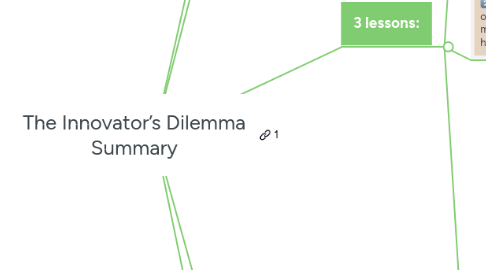
1. 1-Sentence-Summary:
1.1. The Innovator’s Dilemma is a business classic that explains the power of disruption, why market leaders are often set up to fail as technologies and industries change and what incumbents can do to secure their market leadership for a long time.
2. Favorite quote from the author:
2.1. "Disruptive technology should be framed as a marketing challenge, not a technological one." - Clayton M. Christensen
3. 3 lessons:
3.1. There is disruptive technology and sustaining technology, and innovation works differently for the two.
3.1.1. The author distinguishes between two kinds of technologies:
3.1.1.1. Sustaining technologies. These focus on growing existing technologies by enhancing their performance, mostly through extended functionality or increased capacity.
3.1.1.2. Disrupting technologies. These change the landscape of an entire industry, or spark a new one altogether, because they solve a problem in an entirely new way or for an entirely new group of people.
3.1.2. Established businesses and market leaders shine when it comes to the first kind. They have built up enormous efficiencies and vast amounts of resources, which make it easy to provide incremental progress at scale.
3.1.3. Where incumbents often lack imagination and swiftness is in disruption.
3.2. When the resources, processes and values of a company don’t match the target market, even the best management won’t help.
3.2.1. The reason startups have a chance to overtake industry titans when it comes to disruption is that it starts in low-margin niche markets, because the target customer is often an entirely different one than before.
3.2.2. Big companies are slow in serving these, because two of the three defining factors of a business’s culture and capability to act are rigid for them:
3.2.2.1. Resources. Anything you can buy, sell, hire or fire.
3.2.2.2. Processes. Patterns of action and communication, both formal and informal.
3.2.2.3. Values. The criteria by which managers and employees make all organizational decisions.
3.2.3. Market champions are loaded with resources, but have very hardened processes and a fixed set of values, which rarely matches the new target market of a disruptive innovation.
3.2.4. The three factors are increasingly hard to change, especially short-term
3.2.5. When you’re processes and values don’t match the market disruption forces you to break into, even the greatest management won’t be able to salvage that dilemma.
3.3. The way market leaders solve the innovator’s dilemma is through equipping independent subsidiaries with what they need.
3.3.1. You should accept the limitations of your processes and values. It’s almost impossible to do well in developing both sustaining and disrupting technology from one source.
3.3.2. As a result, big businesses usually either try to force the new market to grow too fast, or wait too long and end up with a losing position.
3.3.3. Here’s the solution Christensen proposes: Found or acquire a subsidiary company with the right values and processes, equip it with the necessary resources, and let it do its thing.
3.3.4. If you’re off in two of three factors, well, use the third to make up for the other two!
3.3.4.1. When you have a lot of cash and people, deploy some of those in a bold move to try and build something that matches what the market needs, even before it knows it.
